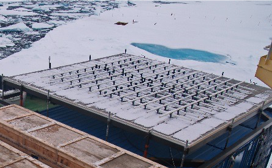Ola Persson
Wind profiler moment data was obtained using a Doppler radar wind profilers transmitting at 449MHz. Using the Doppler shift of the return signals and algebra, the wind speed and direction as a function of height, can be estimated. The wind profiler is sensitive to water vapor in the atmosphere and hence performs best in moist air. It was deployed at the start of the ice drift and was located on the port side top of three containers on the roof of the foredeck lab at the icebreaker Oden and operated through the rest of the expedition.
Download data
Visit web site
Citation
Ola Persson (2018) Wind profiler moment data from the high-Arctic ASCOS expedition 2008. Dataset version 1. Bolin Centre Database. https://doi.org/10.17043/oden-ascos-2008-wind-moment-1
References
Tjernström, M. et al. 2014. The Arctic Summer Cloud Ocean Study (ASCOS): overview and experimental design. Atmospheric Chemistry and Physics, 14, 2823–2869. https://doi.org/10.5194/acp-14-2823-2014
Data description
This zip_file contains moment data from the 449 MHz wind profiler on the Oden during ASCOS. Version 1 contains netcdf files of the ~ 4 minute moment data for each radar beam. It only contains data from the drift portion of the cruise (YD228-245; Aug. 15 – Sep. 1). During the drift, various radar parameters were used between YD228 andYD234. The moment data for YD228, YD234 through YD244, and YD245 are calculated after the spectral data has undergone subjective hand-editing. The moment data for the other days (YD229-233, YD244) have not undergone the hand-editing, though it has been scrutinized and subjectively validated as “usable” by an experienced engineer. The computation of the moments from the spectra uses a wavelet/multi-peak picking technique optimized to identify the wind signal in the spectra. The data is free to use, but it is recommended to contact the PI in advance. [Dr. Ola Persson ([javascript protected email address])].
Each daily moment netcdf file contains:
YD: Decimal year day at the beginning of the dwell for 2008 (Greenwich Mean Time, Note: 2008 was a leap year)
Az: azimuth of the antenna beam in integer degrees
Elev: Elevation angle of the antenna beam in integers of .01 degrees
Lat/lon: latitude/longitude of Oden at beginning dwell time
Shphdg:Ship heading at beginning dwell time
PW: Length of the transmitted pulse in ns (integer)
IPP: InterPulsePeriod in microseconds (integer).
Height: Height of the center of the scattering volume above sea level in meters (integer)
Range: Distance to the center of the scattering volume from the radar, in meters (integer)
Vel: Radial velocity of the scatterers chosen in m/s (float)
Width: Spectral width in m/s (float)
snrdB: ratio of the power in the selected signal to the total noise power in the spectrum, dB units (float)
noiselvl: average spectral noise power in linear power units (float) Note that total noise power in the spectrum is noiselvl*number of points in the spectrum.
SPNdB: Total power contained in the spectrum, Signals Plus Noise, in dB units. This is the sum of all the points in the power spectrum.
SigdB: Signal power of the selected signal, in dB units. This should be related to reflectivity.
Specific variable information and units are found in the netcdf header information. The netcdf global attribute information is given below.
Comments
Two Doppler wind profilers were used in ASCOS; one radar profiler transmitting at 449MHz and one SODAR (SOund Detection and Ranging) transmitting audible sound pulses at several wave lengths. Both work from the same principles, transmitting beams at an angle to the vertical in different directions. Using the Doppler shift of the return signals and algebra the wind speed and direction can be estimated. Both instruments are phased-array instruments, meaning that there are no moveable parts generating the different beams at different angles; this is instead accomplished electronically.
The 449MHz wind profiler is sensitive to water vapor in the atmosphere and hence has the best results in moist air, and was deployed at the start of the ice drift on top of the port three containers located on the roof of the foredeck lab and operated through the rest of the expedition. Its return signal strength can, in addition to the Doppler information, be used to analyze the vertical structure of the atmosphere but only in a relative sense since the water vapor content is variable.
The SODAR is sensitive to water vapor fluctuations (turbulence) and its return signal can therefore, in addition to the Doppler information, be used to derive information about turbulence in the boundary layer. The SODAR is sensitive to ambient noise and hence was deployed on the ice and only operated during the ice drift.
Original address: http://www.ascos.se/index.php?q=node/280
Files:
ASCOS_data_449windprofiler_moments_netcdf_v1.ZIP (37.99 MB)
